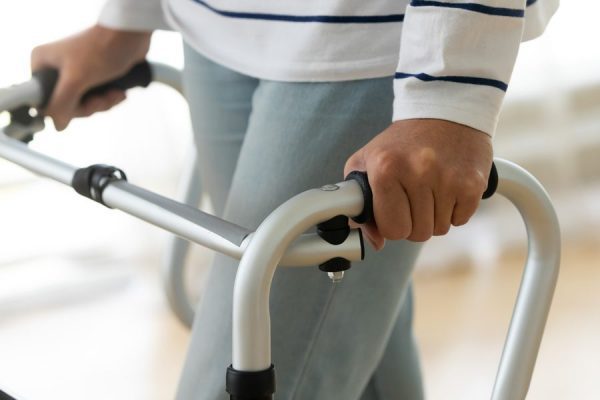Why do hospital falls happen and how can we prevent them?

A patient’s falls risk and mobility is everybody’s responsibility. (Shutterstock)
When a patient falls in hospital, it can lead to a ‘stacking’ effect, where physical injuries and/or a loss of confidence usually mean an extension of their stay. That impacts the patient, their family and staff, with more resources needing to be diverted to that patient.
RBWH registered nurse Jacob Haberley recently spoke to the Five Things Nursing Podcast about the impacts of hospital falls and, crucially, what can be done to prevent them.
Why do patients fall?
Outside of a hospital setting, 32 per cent of falls are from tripping on an object on the ground, quite often carpet.
In hospital that is less of an issue, primarily due to non-carpeted floors.
The primary contributors to falls in a hospital setting are:
- Delirium, dementia and cognitive impairment
- Environmental issues – limited space in a hospital ward environment
- Issues of incontinence and the shame associated with that – the patient may make a decision to try and get to the toilet as quickly as they can
- A degree of physical frailty or disability – age is a significant contributor
- Visual impairments – age is also a factor here
- Neurological and sensory concerns – can be a result of diabetes
- Significant time on bedrest for older patients sees fairly rapid degradation (2-3 per cent in one day of bedrest) in muscular function and a patient’s ability to independently mobilise
- Medications can have an effect on perception and balance.
“Having a buzzer close by and having a plan to get patients to the toilet is absolutely critical when it comes to preventing falls. Ideally you would want to be checking on patients several times an hour but that is not always practically possible,” Jacob said.
How do you screen for the risk of falls?
Risk assessments are important but shouldn’t replace clinical judgement.
“Taking a comprehensive history of the patient is essential and especially so for falls risk. It’s very important to ascertain the patient’s previous level of function. Do they use a walker or walking stick? How do they usually get around?” Jacob said.
Assessing for injury, pain and disability is also important. An injured leg could cause a patient to limp and stumble or be hesitant to mobilise at all.
“Another step is identifying concerns relating to incontinence. If they have urgency incontinence, you need to be able to rapidly attend to them,” Jacob said.
What is the impact of falls on patients?
The clearest is the physical impact.
This can result in head injuries – which can then have more severe consequences down the line, such as brain haemorrhages. As well as being traumatic for patients, these may also require a significant amount of hospital resources, like CT scanners.
Fractures are also a possibility – to whichever part of the body the patient happened to land on.
Falling once can also cause patients to be very wary of falling again, leading to a kind of mental block towards further mobilising. And that can have a significant impact on a patient’s recovery.
Essentially, falls tend to add to a person’s time in hospital – which leads to a stacking effect on the patient, staff, resources and other patients.
How do we prevent falls?
There are some practical strategies bedside nurses can implement to prevent falls, according to Jacob:
- Exercise clinical judgement. The majority of patients can mobilise and it’s important to facilitate mobility wherever possible.
- Ensure adequate pain management. Patients will be more willing to mobilise in a way that is safe if pain is under control.
- Prevent inpatient functional decline as much as possible. 900 steps is the daily requirement to prevent functional decline due to bedrest.
- Be mindful of any changes in medications.
- Keep the environment as clutter-free as you practically can.
- Make sure the patient is able to access their buzzer.
Jacob said there is no hard evidence that restrictive practices (such as bedrails), bed alarms or grippy socks have any effect in reducing falls.
The role of stakeholders
A patient’s falls risk and mobility is everybody’s responsibility – clinicians, family and community supports. Everyone from cleaners to dietitians can contribute.
Sitting out of bed leads to better food intake. Cognitive activities with patients are helpful. A lack of mental engagement can quickly result in delirium.
“Patients love a change of scenery. Family members who visit should encourage them to get up and about, even if it means a walk around the ward,” Jacob said.
You can listen to more of Jacob’s advice on hospital falls on RBWH’s Five Things Nursing Podcast with Dr Liz Crowe and Jesse Spurr.
